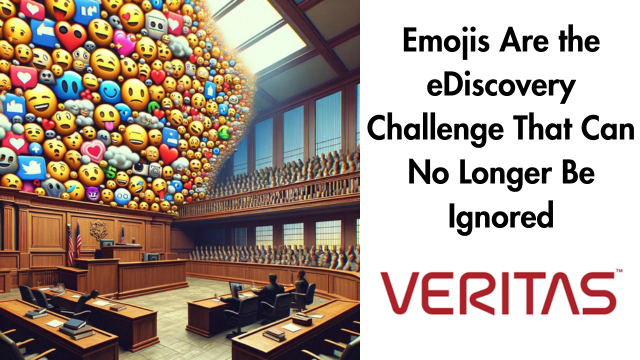
[EDRM Editor’s Note: EDRM is happy to amplify our Trusted Partners news and events. The opinions and positions are those of Veritas and Irfan Shuttari. This article was first published on December 13, 2023].

Emojis have become a fundamental part of modern communication today. They are extensively used in social media, text messaging, collaborative apps and (of course) email. Emojis add tone and context to messages which might otherwise have a different interpretation in text form. They are used extensively today, not just in personal communications, but also in business communications.
Of course, their extensive use in both types of communications today means one thing to eDiscovery professionals: they’re discoverable. While many eDiscovery professionals have been inclined to ignore emojis in discovery as non-consequential to the case, their increased significance in litigation means they can no longer be ignored. In this article, I’ll discuss how the influence of emojis on litigation has risen dramatically, and what to look for in an eDiscovery solution to identify any emojis that may impact your case.
In this article, I’ll discuss how the influence of emojis on litigation has risen dramatically, and what to look for in an eDiscovery solution to identify any emojis that may impact your case.
Irfan Shuttari, Director of eDiscovery Strategy, Product Management at Veritas.
Recent Examples of Emojis Influencing Cases
According to Eric Goldman, case law rulings referencing emojis have risen from a single case in 2014 to 154 cases in 2021! That’s enough to put a “worried face” on any eDiscovery professional! Here are three recent examples to illustrate how emojis have influenced cases:
- The “Heart Eyes” Emoji Case: In Rossbach v. Montefiore Med. Ctr., where the plaintiff alleged sexual harassment and wrongful termination, she produced an image that represented a text exchange between her and her supervisor that appeared to back up her claim, which included a “heart eyes” emoji. She claimed she received the messages on her iPhone 5, but because the phone was so damaged (with a cracked screen and ink bleed), she took a picture of the text message exchange on the iPhone 5 screen using an iPhone X. The image did not show any screen cracks or ink bleed, casting doubt on the plaintiff’s story. Even more significant was that the “heart eyes” emoji depicted in the image was the version displayed on iPhones running OS 13 or later, and it was impossible for an iPhone 5 (running OS 10) to display that version of the emoji. The image was ruled to be a fabrication, and the case was dismissed with prejudice.
- The “Thumbs Up” Emoji Case: Here, the case went to court after a farmer failed to deliver 86 tons of flax that a grain buyer was looking to purchase in 2021, prompting the grain buyer to take legal action. After discussing the potential purchase, the grain buyer texted the farmer a draft of a contract, writing “please confirm flax contract”. The farmer responded with a “thumbs-up” emoji but did not deliver the flax by the date specified. The Court relied on a Dictionary.com definition of the emoji, which states that “it is used to express assent, approval or encouragement in digital communications” and fined the farmer over $61,000 for failing to fulfill the contract.
- The “Smiley Moon” Emoji Case: In this case, an investor in Bed Bath & Beyond was sued over an alleged “pump-and dump” scheme to inflate the value of the stock before selling. At issue was a tweet issued by the investor in response to a negative story about Bed Bath & Beyond which included a “smiley moon” emoji, which the plaintiff claimed indicated the investor’s representation that the stock price was going “to the moon” (i.e., rising), before he subsequently sold the stock a few days later. Ruling that the plaintiff “plausibly alleged that the moon emoji has a particular meaning in the context in which it was used” and that meaning of it was “actionable”, the Court refused to dismiss the plaintiff’s claim.
The farmer responded with a “thumbs-up” emoji but did not deliver the flax by the date specified. The Court relied on a Dictionary.com definition of the emoji…
Irfan Shuttari, Director of eDiscovery Strategy, Product Management at Veritas.
Addressing Emojis in Discovery
With emojis becoming discoverable more often in discovery, it’s important to have an eDiscovery solution that can enable you to locate those emojis to make responsiveness determinations on the messages containing them. There are two capabilities that are needed for addressing emojis in discovery:
- Search for a Specific Emoji: The eDiscovery solution should provide the ability to search for a specific emoji to address known issues through copying and pasting of that emoji into the search box. For example, in cases 2 and 3 above, a logical search would be to search for other examples of the “thumbs up” or “smiley moon” emoji to establish a pattern of use.
- Search for Any Message Containing an Emoji: The eDiscovery solution should also provide the ability to search for any message containing an emoji in the collection. To do that requires emojis to be identified during processing so that a classifier can be set for the message containing the emoji – then, that classified can be included in searches. A logical search example here might be to search for any emoji included in a message sent or received by a custodian known for frequently using emojis to see if there are potential issues associated with them.
Conclusion
Case law is always a terrific indicator of potential issues to address in discovery. Based on case law trends and recent specific examples, the increased significance of emojis in litigation means they can no longer be ignored.
When selecting an eDiscovery solution, it’s important to ask about their ability to search for emojis and request a demo of that capability. The platform should be able to support search for either a specific emoji or any emoji within your document collection. Turn that “worried face” into a “beaming face with smiling eyes” by ensuring that your eDiscovery solution can support emojis!
For information regarding how Veritas Alta™ eDiscovery can optimize your eDiscovery workflow, click here.


